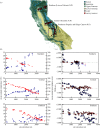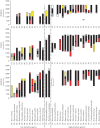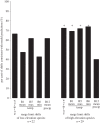Spatially heterogeneous impact of climate change on small mammals of montane California
- PMID: 25621330
- PMCID: PMC4286042
- DOI: 10.1098/rspb.2014.1857
Spatially heterogeneous impact of climate change on small mammals of montane California
Abstract
Resurveys of historical collecting localities have revealed range shifts, primarily leading edge expansions, which have been attributed to global warming. However, there have been few spatially replicated community-scale resurveys testing whether species' responses are spatially consistent. Here we repeated early twentieth century surveys of small mammals along elevational gradients in northern, central and southern regions of montane California. Of the 34 species we analysed, 25 shifted their ranges upslope or downslope in at least one region. However, two-thirds of ranges in the three regions remained stable at one or both elevational limits and none of the 22 species found in all three regions shifted both their upper and lower limits in the same direction in all regions. When shifts occurred, high-elevation species typically contracted their lower limits upslope, whereas low-elevation species had heterogeneous responses. For high-elevation species, site-specific change in temperature better predicted the direction of shifts than change in precipitation, whereas the direction of shifts by low-elevation species was unpredictable by temperature or precipitation. While our results support previous findings of primarily upslope shifts in montane species, they also highlight the degree to which the responses of individual species vary across geographically replicated landscapes.
Figures




References
-
- Parmesan C. 2006. Ecological and evolutionary responses to recent climate change. Annu. Rev. Ecol. Evol. Syst. 37, 637–669. (10.1146/annurev.ecolsys.37.091305.110100) - DOI
Publication types
MeSH terms
LinkOut - more resources
Full Text Sources
Other Literature Sources
Medical

